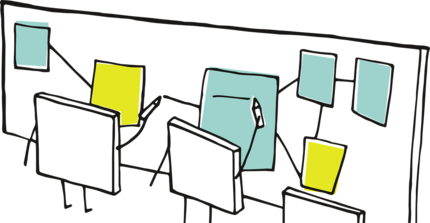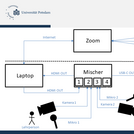Hybrid teaching formats
Under the constraints of containment regulations and hygiene requirements, many universities rely on so-called hybrid teaching concepts in order to enable a minimum of face-to-face teaching. On this page, you will find an overview of what is meant by hybrid teaching concepts, what needs to beconsidered when implementing them, which teaching-learning scenarios are suitable for practical use, and what experiences lecturers at the University of Potsdam have already had with this form of teaching.
What are hybrid teaching concepts?
The term "hybrid teaching formats" describes teaching-learning scenarios where some students attend the course while others can participate remotely via Zoom or another conferencing technology. These concepts represent a new blend of face-to-face and digital teaching that differs from previous concepts, such as integrated learning (formerly: blended learning) or flipped or inverted classroom.
A combination of these concepts, fusing face-to-face and online participation with the option of asynchronous teaching, is called the "HyFlex" model. Here, each course date and all associated learning activities are offered in a real room on campus and synchronously online. Each course dateis also recorded so that students can also "participate" asynchronously. The course format was developed at San Francisco State University (for more details, see ELI, 2020), among others, and has since been implemented and further developed at other universities. In order to provide equal opportunities for all students, the HyFlex model represents a suitable concept to be realised. This way, students can take advantage of the benefits of teaching-learning, be it synchronously on campus, online or asynchronously. At this point, however, we would like to point out that this model is very demanding and is therefore recommended for teachers who already have experience with online teaching.
In a nutshell:
- Hybrid teaching: face-to-face and online teaching take place synchronously
- HyFlex model: face-to-face and synchronous online activities, as well as equivalent asynchronous options
More information:
Framework conditions, challenges and scenarios of hybrid teaching formats
Which framework conditions are important?
- All students can participate synchronously, be it on campus or online. If students cannot participate synchronously for various reasons, an adequate digital learning offer should be made (see HyFlex model).
- To participate synchronously, students must comply with a set of framework conditions, such asa quiet workplace, stable Internet connection, or an appropriate schedule.
- Support and assistance is usually required for the implementation of hybrid formats. If the participants on campus are meant to participate actively, two additional teachers are recommended.
- A text-based communication channel (e.g. Zoom chat) should be available for students, in case audio or video is not available.
- If students are to participate in online activities while present (collaborative editing of documents, voting, etc.), mobile devices and an adequate internet connection must be available.
The university's facilities and staff will do their best to support you in implementing your desired scenarios. However, please keep in mind that even then the scope of possible support will be limited– especially in the case of events that take place in paralell.
Challenges and alternatives of hybrid teaching formats
Equal opportunities
- As far as it is possible, balancing unequal situations so that students can learn online, on campus and asynchronously under similar conditions
Additional effort
- Teaching in both modes and adjusting course scheduling accordingly
- Moderating interaction between both modes
- Simultaneous supervising of on campus and digital group work
Technical know-how and equipment
- Providing, setting up and using the necessary technology
- Ensuring a stable wifi connection with larger groups, simultaneous transmission or online participation
Alternatives to hybrid formats
Hybrid formats are costly and should only be used if no simpler alternatives are possible:
- Lectures can be recorded, while debriefings and Q&A sessions can be enabled separately in a video conference or on campus
- Time on campus can be used for subgroups, if necessary. Integrated scenarios or blended learning can also be carried out with subgroups.
Teaching-learning scenarios in hybrid teaching format
To get an overview of how you can implement hybrid teaching-learning scenarios, please consult our list of selected possibilities below. In addition, you will find set-up plans that show you which technical requirements need to be considered when planning and implementing hybrid teaching formats.
Lecture / Presentation with questions
Group discussion
Group work
At a glance: Structure plans for hybrid teaching formats
Field reports from the University of Potsdam
In recent semesters, teachers have repeatedly reported on successfully implemented hybrid events. Ideas range from synchronous combinations of face-to-face and digital teaching to hybrid, digital teaching formats, where students from different countries come together. In the following section, we will present to you three selected practical examples, which serve as a first insight into practical hybrid teaching formats.
On-site and at home - when face-to-face teaching and digital teaching take place simultaneously
The first part is the worst part... and incredibly exciting! An online meeting between Potsdam and Uppsala
Safe spaces and the opportunity to learn from scientists from all over the world
Handouts and further literature
Below you can find current handouts and articles on the topic of "hybrid teaching formats". These give even greater insight and serve as an opportunity to delve deeper into the topic. In addition, the two handouts "Hybrid Teaching Concepts" and "HyFlex Models" can be used as an cheat sheet for planning and implementing your courses.
- [Handout] Hybride teaching concepts (PDF 242KB)
- [Handout] HyFlex-models (PDF 195KB)
Your contact persons
E-Learning coordinators of the faculties
The following people are particularly familiar with the topic of "hybrid teaching formats":
Mathias Loboda (Faculty of Economics and Social Sciences)
Marc Beilcke (Faculty of Mathematics and Natural Sciences)
Philipp Nern (Faculty of Human Sciences)
Jenissa Terzic (Faculty of Law)
Jakob Arlt (Faculty of Humanities)
You can reach all e-learning coordinators via the e-mail address elearning-kosuuni-potsdampde.
Center for Information Technology and Media Management (ZIM)
ZIM Service (Questions about technical realization)
The Department of Teaching and Media of the Center for Quality Development in Teaching and Learning (ZfQ)
Marlen Schumann (didactical questions)
Peter Kiep (didactical questions)




